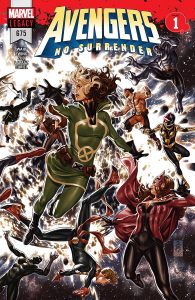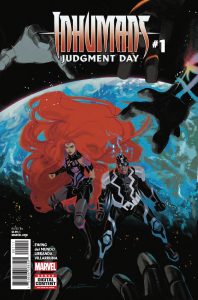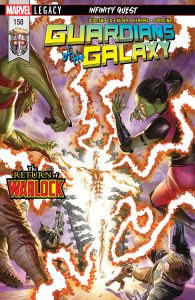Welcome to Monthly Marvel Muster, as we look back on January. This column we have two character resurrections, the start of the much-hyped weekly Avengers: No Surrender, and a whole lot of miniseries and one-shots.
Marvel had no new ongoing comics in January, but made up for it with five new miniseries and five one-shots. Rise of the Black Panther by Evan Narcisse and Paul Renaud is a deep dive into T’Challa’s backstory, nicely timed to coincide with the much-anticipated new movie. Legion by Peter Milligan and Wilfredo Torres is David Haller’s first appearance since the end of X-Men Legacy in 2014, and also Milligan’s first work for Marvel since 2014. Rogue & Gambit by Kelly Thompson and Pere Pérez pairs the fan-favourite on-again off-again couple in their first ever series together. Old Man Hawkeye by Ethan Sacks and Marco Checchetto returns to the dystopian future of Old Man Logan, this time focusing on an aging Clint Barton. And finally, Marvel’s Avengers: Infinity War Prelude by Will Corona Pilgrim and Tigh Walker is the latest Marvel Cinematic Universe tie-in/prequel. I’m kind of fascinated by the MCU prelude comics. I know a lot of MCU fans, but I don’t think I know anyone who reads them and they don’t appear to get high sales in general, and yet Marvel releases one before every new movie.
In one-shots there was something for just about everyone. The short Venom/Amazing Spider-Man crossover ended in January with Amazing Spider-Man: Venom Inc. Omega #1 written by Dan Slott and Mike Costa with art by Ryan Stegman and Gerardo Sandoval. The current era of Inhumans comics wrapped up with the Inhumans royal family all back on earth in Inhumans: Judgment Day #1 by Al Ewing and Mike Del Mundo. Judgment Day wraps up the story from the recently-ended Royals and leaves Marvel with no flagship Inhumans book after three years of heavy line-wide focus on Inhuman character and storylines. X-Men Gold Annual #1 written by Marc Guggenheim and Leah Williams with art by Alitha E. Martinez celebrates the 30th Anniversary of Excalibur #1 with a mini-reunion written in a passable pastiche of Chris Claremont’s early issues of the series. X-Men Blue Annual #1 by Cullen Bunn and Edgar Salazar is the beginning of yet another Venom crossover. And finally, Star Wars: The Last Jedi – DJ #1 by written by Ben Acker and Ben Blacker with art by Kev Walker is a Star Wars: The Last Jedi tie-in introducing some backstory for one of the new characters in the film.
Two ongoing series ended in January, the well-reviewed but poorly read Secret Warriors by Matthew Rosenberg, and Gerry Duggan’s run of Guardians of the Galaxy, which started off as All-New Guardians of the Galaxy before returning to the adjectiveless name and legacy numbering with issue #146. Secret Warriors seems to be gone for good, but Guardians of the Galaxy is ending to make way for the Infinity Countdown event, so I’m sure it will return in a few months, albeit possibly with a new creative team.
BIG STORYLINES
AVENGERS: NO SURRENDER

In November Marvel had three very different Avengers titles: Avengers by Mark Waid and Jesus Saiz, U.S. Avengers by Al Ewing and Paco Diaz, and Uncanny Avengers by Jim Zub and Sean Izaakse. Now they have one. The flagship Avengers title is now being written by Waid, Ewing, and Zub together with art by Pepe Larraz, and it’s coming out weekly for the next four months.
Marvel has billed Avengers: No Surrender as a “stunning sixteen-part saga that will write the end of an era,” and four issues in I can say that it’s not particularly stunning, really not much of a saga, and definitely not sixteen issues’ worth of a story. Mostly, it’s a lot of confusing fight scenes and unanswered questions interspersed with some good character moments and stretched out to take up about twice as much space as needed.
And here’s the thing: if this story was coming out monthly or even twice-monthly I might be willing to give it a little longer to find its feet, but as a weekly I just can’t. The cover price on a Marvel print comic is currently $3.99 USD. I’m in Canada, so with exchange rate I’m paying about $5.00 CAD an issue. $20.00 a month is a LOT of my monthly comics budget to be tied up in one title. It needs to be either really great or a really limited run to be worth that, and Avengers: No Surrender is neither.
The weekly Avengers schedule is the latest in a growing trend at Marvel of publishing ongoings and miniseries weekly or biweekly, and I’m really not feeling it. There is only so much I can justify spending on comics a month and factoring in weekly and bi-weekly books reduces the diversity of my reading without a corresponding increase in the quality of the stories.
THE PHOENIX FORCE VS. TWO JEAN GREYS

The much-hyped (and once again, weekly) Phoenix Resurrection by Matthew Rosenberg and various artists started out strong with December’s issue #1, but it mostly treaded water for the next three issues, with the X-Men chasing phantoms on earth and Jean almost but never quite seeing through the Phoenix’s illusions in the White Hot Room.
Jean got her memory back and actually started taking action and making some choices in the final issue, but there’s a big chunk in the middle of the series where she just seems to have no agency at all. The plot is happening around her, but it’s not really happening because of any choices or decisions she’s making.
The ultimate resolution, which posits Jean’s relationship with the Phoenix Force as innately toxic and is framed essentially as Jean breaking up with it, is actually quite well done. The Phoenix Force has been rather inconsistently described over the years, and the exact nature of its relationship with Jean Grey has changed as well, but one thing that has been consistent is the way they keep returning again and again to each other. No matter how many other hosts it finds, the Phoenix always returns to Jean, and Jean can never quite give up the possibility of taking up that power again. Jean couldn’t just refuse the Phoenix yet again, she needed to break up with it once and for all.
Meanwhile, the other Jean Grey has been having her own face-off with the Phoenix Force. The entirety of Dennis Hopeless’s Jean Grey series, starring the younger time-displaced version of the character, has been about young Jean’s resistance to ever becoming host to the Phoenix. It’s been an inconsistent series, with some fantastic issues and some that were honestly quite terrible, but it has addressed the Phoenix’s long history with Earth and its numerous mutant hosts much better than some recent much more high profile series have.
Unlike Phoenix Resurrection, Jean Grey has been all about Jean having agency over her own life and fighting to live it on her own terms. In Jean Grey #11 she comes face to face with a recently-dumped Phoenix Force and it is determined once and for all that a) she is not a version of the old Jean, but very much her own person and b) she is never letting the Phoenix Force into her life.
THE END OF AN INHUMAN ERA

After years of letting them languish as mostly peripheral characters, Marvel has recently been really pushing the Inhumans as an integral part of the comics universe, starting with the detonation of the Terrigen bomb during the 2013 Infinity event leading to a great number of new Inhumans including the breakout teen superhero Ms. Marvel.
The big push of attention on the Inhumans had mixed results and while individual series such as Ms. Marvel and Moon Girl & Devil Dinosaur have been incredibly successful, the various main Inhuman series have never really taken off.
The most recent Inhuman team book was Royals by Al Ewing and a rotating series of artists, which followed a group of Inhumans led by their queen Medusa into space as they searched for a replacement for the Terrigen Mists, which were used to unlock Inhuman powers but were destroyed at the end of the Inhumans vs. X-Men event.
Like most of Ewing’s books for Marvel have been, Royals was a single self-contained story, in this case told over a fast-paced twelve issues. The Inhumans went into space, they found an alternative to Terrigen, and they got the attention of a very powerful race of aliens called the Progenitors, who unfortunately followed them home.
Royals is a self-contained story, but it does end on a cliffhanger which was then resolved in January’s Inhumans: Judgment Day one-shot by Al Ewing and Mike Del Mundo. Judgment Day resolves the last few hanging plot points and brings the last four years’ worth of Inhumans storylines to a close. It also marks the end of Marvel publishing any kind of marquee Inhumans team book. As of Marvel’s April 2018 solicitations, there are no new Inhumans books coming to fill the gap left by the end of Royals.
ROGUE AND GAMBIT REUNITED

Despite being an American of just the right age, I actually didn’t grow up watching X-Men: The Animated Series, but for a lot of geeky kids who grew up in the ’90s it was their first introduction to the X-Men. And for many of those kids the tumultuous relationship between Rogue and Gambit was a particular highlight.
Fans turning to the comics for more of that relationship were doomed to disappointment though. In the ensuing decades, Rogue and Gambit have come together and then broken up a seemingly countless number of times, and have both suffered from some inconsistent characterization. Lately their relationship has mostly been a series of uncomfortable interactions where Gambit tries to start things up again and Rogue repeatedly shuts him down.
Kelly Thompson and Pere Pérez’s new Rogue & Gambit miniseries looks to be jumpstarting their relationship once again, this time from the perspective of a writer who grew up watching and reading the X-Men in the era in which it was done best. One issue in it’s a fun and sexy slice of mutant soap opera shenanigans, which is basically the entire reason I read X-Men comics, so I’m happy.
Thompson’s and Pérez have a good feel for the chemistry and intense sexual tension that makes Rogue and Gambit’s interactions so great to watch, but Thompson doesn’t shy away from all the quite valid reasons they’ve never been able to successfully sustain a romantic relationship. A whirlwind tour through the highlights and lowlights of their past together may be just the thing to determine whether or not these two have a future.
GUARDIANS OF THE GALAXY’S INFINITE END

Guardians of the Galaxy #150 marks the apparent end of Gerry Duggan’s run on the book, and it’s a slightly odd ending. Marvel actually solicited Guardians of the Galaxy #151, and also scheduled it to come out in January, before withdrawing that solicitation and saying the series would end with #150.
Issue #150 feels very condensed, like it probably could have benefited from that phantom issue #151. Half the issue is a fairly abrupt ending to the ongoing Nova Corps plot that’s been the focus of the book, the other, stronger half of the story is centered on the resurrection of the powerful Adam Warlock and what role he’s going to play in the upcoming Infinity Countdown event.
Truthfully, my eyes glaze over any time the Infinity Stones get mentioned, so I’m not terribly excited for Infinity Countdown, but I know a lot of people are. Hopefully it’ll make the people who’ve been missing Marvel’s big cosmic events very happy.
JANUARY HIGHLIGHTS
Ms. Marvel #26

writer: G. Willow Wilson
artist: Nico Leon
color artist: Ian Herring
lettering: VC’s Joe Caramagna
This second issue of the Teenage Wasteland arc is also the second issue of Ms. Marvel in a row in which Kamala Khan doesn’t make an appearance. It’s a credit to the quality of the cast G. Willow Wilson has built over the last three years that Kamala’s friends and family can more than carry the book on their own. I won’t claim I don’t miss Kamala, because I pretty much always miss Kamala, even in books she’s never been in, but the story does not suffer for lack of her presence.
No one but her family seems to know where Kamala Khan is, and Ms. Marvel is similarly missing in action. In Ms. Marvel’s absence, Kamala’s friends Nakia, Zoe, Mike, and Gabe have been trying to take on the role of Ms. Marvel and patrol Jersey City in her stead.
The entire cast of this book is wonderful, but what absolutely makes this story is the focus on Zoe, a character who was introduced as the somewhat clueless popular girl in the first issue of the series, but who has grown into a wonderfully complex and nuanced character since then. Zoe doesn’t have Ms. Marvel’s powers, and she doesn’t have Kamala’s strategic intelligence, but she’s smart and brave and able to make quick connections. When she inevitably gets in over her head it’s not because she’s incompetent or ignorant, it’s because even though she doesn’t have any superpowers or superhero training she’s stepping up to try to do a superhero’s job. And I really appreciated that. Kamala’s friends aren’t presented here as any less intelligent and competent and morally centered than Kamala. Each and every one of them is worthy of wearing Ms. Marvel’s costume and filling her shoes, they’re only lacking in the necessary physical skills.
Nico Leon’s art is excellent, with great facial expressions and body language and a real feel for physical humor, but I want to particularly call out Ian Herring’s coloring. Ms. Marvel has had a variety of artists, and while they’ve all had similar styles, what’s actually kept the book feeling incredibly stylistically consistent is that Herring has colored every issue. Despite the varied artists this book has an incredibly coherent look and feel and a big part of that is the consistent coloring.
Rise of the Black Panther #1

writer: Evan Narcisse
consultant: Ta-Nehisi Coates
artist: Paul Renaud
color artist: Stéphane Paitreau
In a rare moment of successful corporate synergy, Marvel has several miniseries and one-shots coming out to coincide with the release of the long-awaited Black Panther movie. Rise of the Black Panther is the first of them, a deep dive into T’Challa’s backstory, starting all the way back with his grandfather Azzuri’s meeting and team-up with Captain America and then his father T’Chaka’s time as King.
The strength in Rise of the Black Panther #1 is in the way it centers the experiences and backstory of T’Challa’s two mothers. The first two-thirds of the issue is narrated as a letter to a young T’Challa from his biological mother N’Yami. After his birth and N’Yami’s death, the story is taken up by his adopted mother Ramonda.
T’Chaka’s two loves. T’Challa’s two mothers. They’re both given prominence and both given a voice to tell their own stories, from their own perspectives. That’s distressingly rare in superhero comics where mothers, whether living or dead, rarely get the depth and breadth of backstory provided for male parents.
This issue covers a lot of ground, but it does it quickly and cleanly, hitting all the right emotional beats without getting overly bogged down in the little details, and touching on a variety of recognizable non-Wakandan characters while still keeping the focus strongly and fully on Wakanda.

